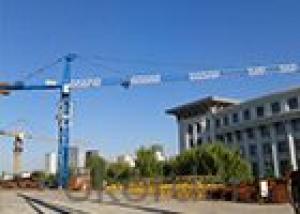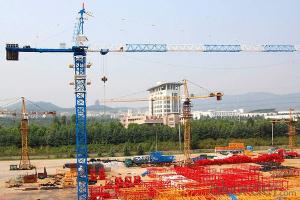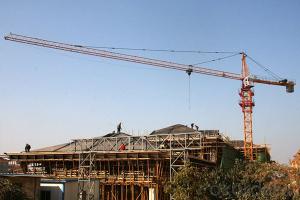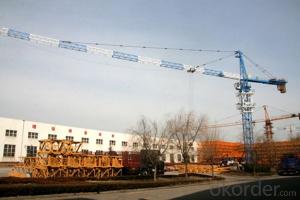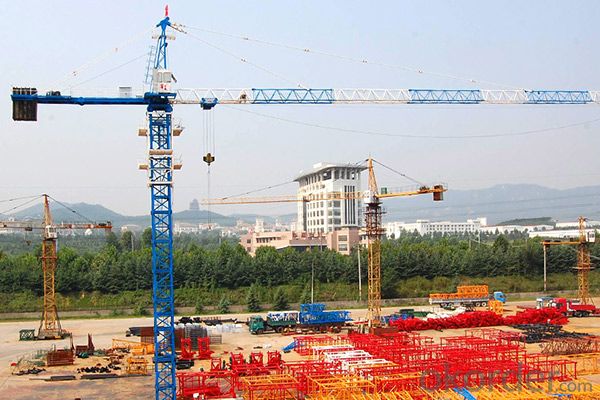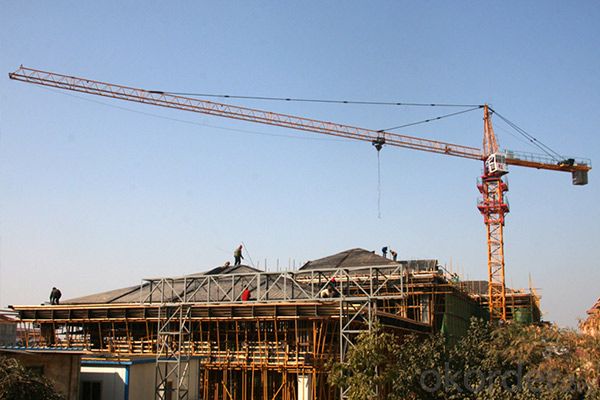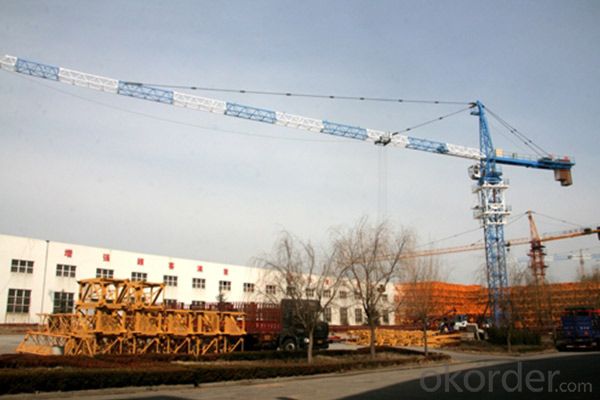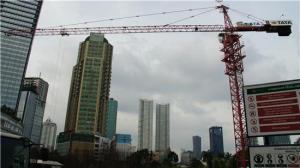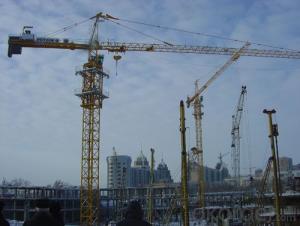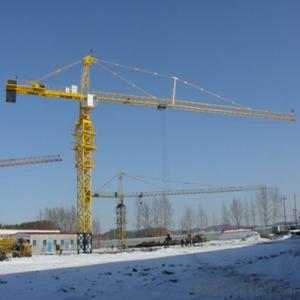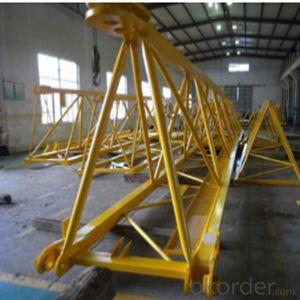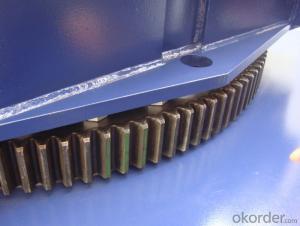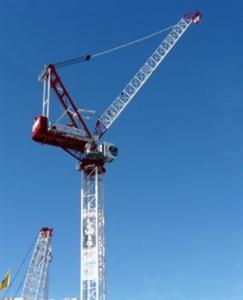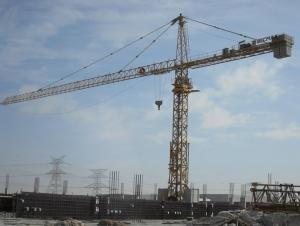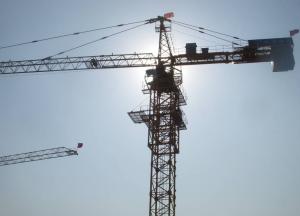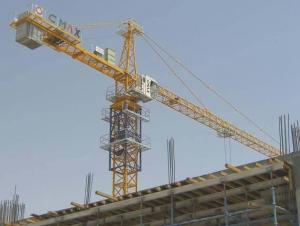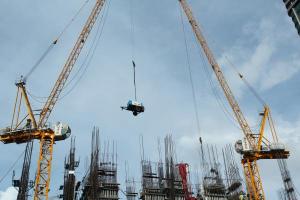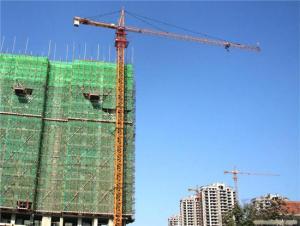QTZ80(TC5513) tower crane
- Loading Port:
- Qingdao
- Payment Terms:
- TT OR LC
- Min Order Qty:
- 1 set
- Supply Capability:
- 12 set/month
OKorder Service Pledge
OKorder Financial Service
You Might Also Like
QTZ80(5513) tower crane tower crane is novel hoisting and conveying machinery which is designed by fully utilizing the group technology, the combinational design technology and the finite element analysis technology and taking the tower crane microcomputer design platform as a tool.
The crane is a horizontal-arm-rest trolley-amplitude upper-revolution hydraulic lifting type crane which has the maximum working amplitude of 56m, the independent lifting height of 40m, the adhesion lifting height of 150m, the rated lifting moment of 710kN•m and the maximum lifting moment of 853.2kN•m. All the performance parameters and technical indexes of the crane meet or surpass national standards.
The crane features advanced parameters, excellent and reliable properties, attractive appearance, high quality, simple and practical structures, advanced safety devices, convenient maintenance, safe usage and reasonable prices, and is ideal construction machinery for many construction enterprises.
The lifting boom and balance boom adopt cantilever boom structure, which reduces the hoisting modular and makes it more safe, convenient and flexible to install and uninstall, and reduces the requirements for hoisting equipment and the site.
2. Multiple special mounting brackets are available, which saves the installation time and ensures safe and quality installation.
3. The lifting boom adopts cantilever boom structure and variable cross-section materials, featuring more reasonable structural stress and long service life; and it is easier to make different combination of boom length.
| Amplitude(m) | 3-13.6 | 14 | 15 | 16 | 17 | 18 | 19 | 20 | 21 | 22 | 23 |
Lifting capacity(kg) | 4000 | 3890 | 3618 | 3380 | 3170 | 2860 | 2810 | 2660 | 2530 | 2400 | 2290 |
Amplitude(m) | 24 | 25 | 26 | 27 | 28 | 29 | 30 | 31 | 32 | 33 | 34 |
Lifting capacity(kg) | 2190 | 2090 | 2000 | 1920 | 1850 | 1770 | 1710 | 1650 | 1590 | 1540 | 1490 |
Amplitude(m) | 35 | 36 | 37 | 38 | 39 | 40 | 41 | 42 | 43 | 44 | 45 |
Lifting capacity(kg) | 1440 | 1390 | 1350 | 1310 | 1270 | 1230 | 1200 | 1170 | 1130 | 1100 | 1070 |
Amplitude(m) | 46 | 47 | 48 | ||||||||
Lifting capacity(kg) | 1050 | 1020 | 1000 |
(2)2-magnification Lifting Performance Table
Amplitude(m) | 3-26 | 27 | 28 | 29 | 30 | 31 | 32 | 33 | 34 | 35 |
Lifting capacity(kg) | 2000 | 1920 | 1850 | 1770 | 1710 | 1650 | 1590 | 1540 | 1490 | 1440 |
Amplitude(m) | 36 | 37 | 38 | 39 | 40 | 41 | 42 | 43 | 44 | 45 |
Lifting capacity(kg) | 1390 | 1350 | 1310 | 1270 | 1230 | 1200 | 1170 | 1130 | 1100 | 1070 |
Amplitude(m) | 46 | 47 | 48 | |||||||
Lifting capacity(kg) | 1050 | 1020 | 1000 |
Technical Performance Parameter Table
Item | Unit | Magnification | ||
α=2 | α=4 | |||
Rated lifting moment | kN.m | 500 | ||
Maximum lifting capacity | t | 2 | 4 | |
Working amplitude | m | 3 ~48 | ||
Maximum amplitude lifting capacity | t | 1.0 | ||
Lifting height | Independent | m | 30 | |
Attached | m | 120 | ||
Time of moving outrigger end to rotation center | m | 48.74 | ||
Time of moving balance arm tail to rotation center | m | 12.816 | ||
Counter weight | t | 7 | ||
Total motor power | kW | 24.9 | ||
Allowable working temperature | 0C | -20~+40 | ||
- Q: A few years ago, my college decided to take down two multilevel dormitories. The demolition company decided to take it down piecemeal with a wrecking ball. The wrecking ball was attached to the crane via a very large tire (just the rubber part, not the inflatable part). I have seen this done on normal cranes and other wrecking balls on TV and was wondering if any professional construction people out there know why they would do this as to me, a guy not in the construction/demolition business, think that might be a bit unsafe.
- Shock absorption. The ball swings toward the building and hits, the energy of that swing is mostly dissipated into the building but also into the cable and cable connectors as the ball bounces back. That shock of the impact resonates and gets dissipated by the tire. It reduces wear and tear on the cable and cable connectors, also on the crane tower. Your car engine has motor mounts of the rubber type of material and it absorbs the resonating vibration of the engine. I have seen the cable connectors, interesting to say the least. The strands are interlaced sometime, and other times I see them clamped together. It would seem important to protect those joints. I do not know all of the crane business terminology, but that would be the gist of it.
- Q: what are the number meanings for paper cranes?
- Hey Mary, Don't let the web site name fool you, it does discuss the deeper meaning behind paper cranes. Steeped in ancient myths and carrying resonant cultural meanings, the crane occupies a central role in the Asian imagination. Anyone who has witnessed cranes flying through the early morning mist over shimmering green rice paddies will readily understand how the mysterious beauty of the crane has captivated Asian life and art for centuries. Like the dragon, tiger, and phoenix, the crane ranks among the favorite motifs for Asian artwork because of its rich meaning and history. Read more at the web sites.
- Q: analysis of jib crane?
- I would suggest that you delete this question and submit a new question with enough details for someone to give you an answer. This is not a question I can give you much help on
- Q: There is no CAD map attached to embedded parts of tower crane?
- What size do you want?. Each model is different. For example, the 5010 tower bolt embedded needs 24.
- Q: is the elevation of the upper surface of the tower crane foundation flat with the elevation of the bottom of the new building? Or lower than the trough bottom elevation? ThirtyI think this is better. Please specify which specification has the relevant regulations. Which page is it? Thank you very much!
- There is no standard in the tower crane foundation and building foundation, there is no such provisions.In fact, you can do whatever you can. The only factor that can be said is the Design Institute, to see if they agree.Design Institute to consider this problem, generally disagree, you let the two based on the surface flat, because there is a stress concentration problems. It's like a pebble under your mattress. So, in general they will demand based on the surface in the construction of tower crane foundation floor, the middle 30-50cm gap with soil pad.Of course, no matter which of these two methods you have to use the back belt to enclose the tower crane foundation.
- Q: What is the Tower crane Roadb track laying criteria?????????
- The okorder ) track in the vertical and horizontal direction is not more than 1 / 1000. (we Should use the standard instrument, two tracks, and keep in10m range ,Measuring not less than 3 periods, respectively,taking the average).
- Q: i need to know:how long is the stock (extended and non-extended)how wide is the stockand how thick is the stockthanks.
- I believe it is pretty difficult to tell and searching the schematics of the crane stock will be as well. Best way is to check out your local gun range and the folks there that shoot guns with crane stocks installed. Also, though I am not too sure about this one, check if the crane stock is compatible for mil-spec buffer tubes and commercial spec buffer tubes. Otherwise, I am very much inaccurate in any of this response.
- Q: It affects my day to day life, especially in the summer, having to cope with crane flies, wasps and moths getting into my house, so I usually just pretty much keep myself in my room, door closed, windows closed to prevent any from getting into my room. If I happen to be near any of these insects I tend to have a panic attack and can't handle it. I have no reason for my fear, I am just afraid of them for no reason. If my room is too hot, I'll just sit in the dark with the window slightly open, in fear of them coming into my room. It's getting silly now and a lot of my friends will tease me about it. Really it's weird, I'm afraid of these insects, however I don't mind spiders (though I will not touch them), or any other insects for that matter. Can anyone help me to overcome my fears?
- There is a reason you fear these, you allow it. Moths and crane flies are totally harmlees, and really nothing more than a nuisance. Over time you develop a fear of them touching you, and eventually even being near them. Because you dwell on this instead of completely ignoring them, you literally brainwash yourself into fearing them. You need to change the way you think about these critters, preferably, not thinking about them at all. At times when they are a nuisance, just deal with them. I had a moth last night fluttering around my lamp, and it finally landed on the curtain. I grabbed it and tossed it out the door. no more moth. I like to sit on my porch at sunset, sometimes I'll watch a little barn spider come out from behind the lamp and spin her web. Often a pesty crane fly will want to buzz in my face,and I just shoo it away. If it gets persistent, I grab them and toss them into the spider web.No more crane fly. (I get those pretty little green lacewing flies too) It is really a matter of learning how to just ignore them, and deal with them when they are a pest. Sounds like you pretty much ignore spiders, try the same with the moths and crane flies.
- Q: What is the allowable range of vertical deviation for tower cranes?
- The specified installation, construction, demolition of tower crane safety technical regulations in JGJ196--2010: the allowable deviation of verticality Tower: in the wind under no-load, the tower axis line should be less than 4 per thousand of the bearing surfaces of the lateral vertical deviation; after the attachment, the highest attachment point following the vertical deviation should be less than 2 per thousand. According to the installation state of tower crane, the deviation range of verticality is divided into 4/1000 or 2/1000. Tower crane maximum independent installation height (maximum installation height, does not need to be attached to the wall of the instructions specified in the free end) and height (the highest point of a tower crane attached to the wall above the height, body the following provisions in the specification of tower crane slewing) the vertical deviation range was 4/1000; tower crane attachment verticality deviation below the allowable range is 2/1000.
- Q: I'm trying to workout the best height of a truss for a ship-to-shore container crane project. The crane will have a 65m outreach, 18m center section and 15m backreach. I was thinking in the region of 2m-3m truss height.Any input would be great.Thanks
- Jimmy: The American Society of Mechanical Engineers (ASME) produces design standards for many types of cranes: see the link below. Many crane owners, licensing and governmental authorities having jurisdiction over cranes require design, fabrication and testing to ASME standards.
Send your message to us
QTZ80(TC5513) tower crane
- Loading Port:
- Qingdao
- Payment Terms:
- TT OR LC
- Min Order Qty:
- 1 set
- Supply Capability:
- 12 set/month
OKorder Service Pledge
OKorder Financial Service
Similar products
Hot products
Hot Searches
Related keywords
